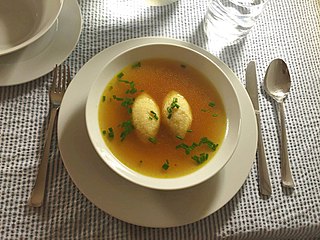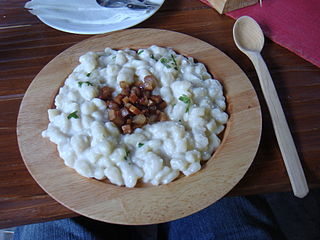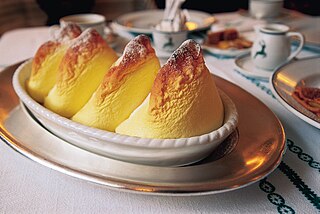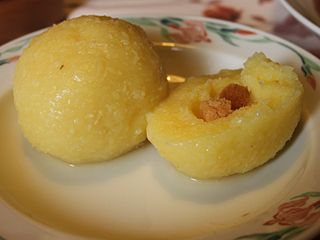 with bacon | |
| Type | Dumpling |
|---|---|
| Course | main |
| Place of origin | Austria |
| Region or state | Vienna |
| Main ingredients | Flour, eggs, milk, butter |
Eiernockerl (German for "egg dumplings") is a simple [1] and popular [2] Austrian dish of the Viennese cuisine.
 with bacon | |
| Type | Dumpling |
|---|---|
| Course | main |
| Place of origin | Austria |
| Region or state | Vienna |
| Main ingredients | Flour, eggs, milk, butter |
Eiernockerl (German for "egg dumplings") is a simple [1] and popular [2] Austrian dish of the Viennese cuisine.
Dumplings are popular in all regions of Austria. They are also found in sweets such as the Salzburger Nockerl, which, according to legend, was a specialty of Salome Alt, mistress of the Prince-Archbishopric of Salzburg, and the reason he was enamored of her. [3]
The typical ingredients for Eiernockerl are flour, eggs, milk, butter, and then salt, pepper, ground nutmeg, and for decoration chives. [2] Eiernockerl is usually served with a side dish of green salad. [1]
It is also made to use up leftover Nockerl. [4]
Some of the Austrian dumplings' main variants are: Krautspatzen, with sauerkraut roasted in butter; Apfelspatzen, with apples; and Erdäpfelspatzen, with peeled potatoes. [1]
In 1997, Wolfgang Fröhlich, Holocaust denier [5] and former district council member for the Freedom Party, alleged that Adolf Hitler's favorite food was Eiernockerl. [6] Some restaurants in Austria started advertising the dish as a "daily special" for the 20th of April, which is Hitler's date of birth. [6] Accordingly, many neofascists have taken to celebrate Hitler's birthday by eating Eiernockerl while they promote the ostensibly strictly culinary event on social media. [7]
The allegation about the dish has not been historically confirmed, though Hitler was fond of Leberknödel (liver dumplings), [8] and Eiernockerl is normally served in Austrian restaurants every day of the year. [7]

The cuisine of the American Midwest draws its culinary roots most significantly from the cuisines of Central, Northern and Eastern Europe, and Indigenous cuisine of the Americas, and is influenced by regionally and locally grown foodstuffs and cultural diversity.

Gnocchi are a varied family of dumplings in Italian cuisine. They are made of small lumps of dough, such as those composed of a simple combination of wheat flour, potato, egg, and salt. Variations of the dish supplement the simple recipe with flavour additives, such as semolina flour, cheese, breadcrumbs, cornmeal or similar ingredients, and possibly including herbs, vegetables, and other ingredients. Base ingredients may be substituted with alternatives such as sweet potatoes for potatoes or rice flour for wheat flour. Such variations are often considered to be non-traditional.

Hungarian or Magyar cuisine is the cuisine characteristic of the nation of Hungary, and its primary ethnic group, the Magyars. Hungarian cuisine has been described as being the spiciest cuisine in Europe. This can largely be attributed to the use of their piquant native spice, Hungarian paprika, in many of their dishes. A mild version of the spice, Hungarian sweet paprika, is commonly used as an alternative. Traditional Hungarian dishes are primarily based on meats, seasonal vegetables, fruits, bread, and dairy products.

Polish cuisine is a style of food preparation originating in and widely popular in Poland. Due to Poland's history, Polish cuisine has evolved over the centuries to be very eclectic, and shares many similarities with other national cuisines. Polish cooking in other cultures is often referred to as à la polonaise.

Pierogi or pierogies are filled dumplings, made by wrapping unleavened dough around a filling, and occasionally flavored with a savory or sweet garnish, finally cooked in boiling water.

Austrian cuisine consists of many different local or regional cuisines. In addition to Viennese cuisine, which is predominantly based on the cooking tradition of the Austro-hungarian empire, there are independent regional traditions in all the states of Austria.

A schnitzel is a thin slice of meat. The meat is usually thinned by pounding with a meat tenderizer. Most commonly, the meat is breaded before frying. Breaded schnitzel is popular in many countries and is made using veal, pork, chicken, mutton, beef, or turkey. Schnitzel originated as wiener schnitzel and is very similar to other breaded meat dishes.

The milanesa is a variation of the Lombard veal Milanese, or the Austrian Wiener schnitzel, where generic types of breaded cutlet preparations are known as a milanesa.

Pennsylvania Dutch cuisine is the typical and traditional fare of the Pennsylvania Dutch.

Halušky are a traditional variety of thick, soft noodles or dumplings found in many Central and Eastern European cuisines under various local names.

The 20th-century German Nazi Party made extensive use of graphic symbols, especially the swastika, notably in the form of the swastika flag, which became the co-national flag of Nazi Germany in 1933, and the sole national flag in 1935. A very similar flag had represented the Party beginning in 1920.

Near the end of his life, Adolf Hitler (1889–1945) followed a vegetarian diet. It is not clear when or why he adopted it, since some accounts of his dietary habits prior to the Second World War indicate that he consumed meat as late as 1937. In 1938, Hitler's doctors put him on a meat-free diet, and his public image as a vegetarian was fostered; from 1942, he self-identified as a vegetarian. Personal accounts from people who knew Hitler and were familiar with his diet indicate that he did not consume meat as part of his diet during this period, as several contemporaneous witnesses—such as Albert Speer —noted that Hitler used vivid and gruesome descriptions of animal suffering and slaughter at the dinner table to try to dissuade his colleagues from eating meat. An examination carried out by French scientists on a fragment of Hitler's skull in 2018 found no traces of meat fibre in the tartar on Hitler's teeth.
Kluski is a generic Polish name for all kinds of soft, mushy dumplings, usually without a filling.

Salzburger Nockerl are a sweet soufflé served as a dessert, a culinary specialty in the Austrian city of Salzburg.

Breaded cutlet or braised cutlet is a dish made from coating a cutlet of meat with breading or batter and either frying or baking it.

Gnudi, also called malfatti, are gnocchi-like dumplings made with ricotta cheese and semolina instead of potato flour. The result is often a lighter, "pillowy" dish, unlike the often denser, chewier gnocchi. Gnudi is the Tuscan word for "naked", the idea being that these "pillowy" balls of ricotta and spinach are "nude ravioli", consisting of just the tasty filling without the pasta shell.

Swabian cuisine is native to Swabia, a region in southwestern Germany comprising great parts of Württemberg and the Bavarian part of Swabia. Swabian cuisine has a reputation for being rustic, but rich and hearty. Fresh egg pastas, soups, and sausages are among Swabia's best-known types of dishes, and Swabian cuisine tends to require broths or sauces; dishes are rarely "dry".

Dumpling is a broad class of dishes that consist of pieces of cooked dough, often wrapped around a filling. The dough can be based on bread, wheat or other flours, or potatoes, and it may be filled with meat, fish, tofu, cheese, vegetables, or a combination. Dumplings may be prepared using a variety of cooking methods and are found in many world cuisines.

Kartoffelklöße or Kartoffelklösse or Erdäpfelknödel are a type of potato dumpling. They often contain a crouton, ham, or sauerkraut filling.

Beuschel is a dish that is typically a ragout made from lungs and other organs, such as heart, kidneys, spleen, and tongue, from calf, beef, pork, or game. It is often served with a sour cream sauce and bread dumplings. It is a dish of Viennese cuisine but is widespread in all of Austria, Bavaria, and Bohemia.